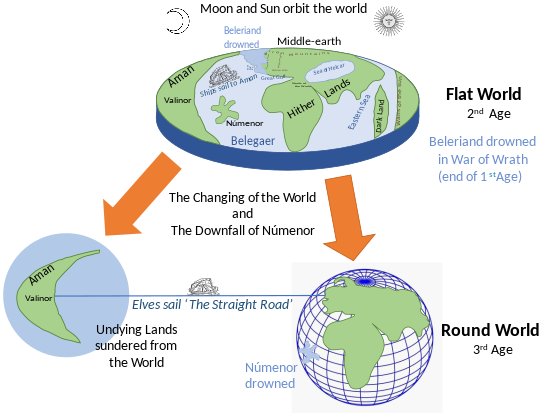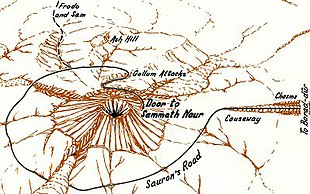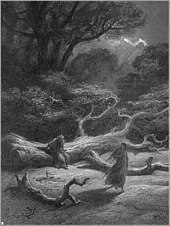Geography of Middle-earth
Thegeography of Middle-earthencompasses the physical, political, and moralgeographyofJ. R. R. Tolkien's fictional world ofMiddle-earth,strictly a continent on the planet ofArdabut widely taken to meanthe physical world,andEä,all of creation, as well as all of his writings about it.[1]Arda was created as a flat world, incorporating a Western continent,Aman,which became the home of the godlikeValar,as well as Middle-earth. At the end of theFirst Age,the Western part of Middle-earth,Beleriand,was drowned in the War of Wrath. In theSecond Age,a large island,Númenor,was created in the Great Sea,Belegaer,between Aman and Middle-earth; it was destroyed in a cataclysm near the end of the Second Age, in which Arda was remade as a spherical world, and Aman was removed so that Men could not reach it.
InThe Lord of the Rings,Middle-earth at the end of theThird Ageis described as having free peoples, namelyMen,Hobbits,Elves,andDwarvesin the West, opposed to peoples under the control of the Dark LordSauronin the East. Some commentators have seen this asimplying a moral geographyof Middle-earth. Tolkien scholars have traced many features of Middle-earth to literary sources such asBeowulf,thePoetic Edda,or the mythicalMyrkviðr.They have in addition suggested real-world places such asVenice,Rome,andConstantinople/Byzantiumas analogues of places in Middle-earth. ThecartographerKaren Wynn Fonstadhas created detailed thematic maps for Tolkien's major Middle-earth books,The Hobbit,The Lord of the Rings,andThe Silmarillion.
Cosmology
[edit]
Tolkien's Middle-earth was part of his created world ofArda.It was a flat world surrounded by ocean. It included theUndying Lands of AmanandEressëa,which were all part of the wider creation,Eä.Aman and Middle-earth were separated from each other by the Great SeaBelegaer,analogous to theAtlantic Ocean.The western continent, Aman, was the home of theValar,and the Elves called theEldar.[T 1][1]Initially, the western part of Middle-earth was the subcontinentBeleriand;it was engulfed by the ocean at the end of theFirst Age.[1]
After the destruction ofNúmenornear the end of theSecond Age,Arda was remade as a round world, and the Undying Lands were removed from Arda so thatMencould not reach them. TheElvescould go there only by theStraight Roadand in ships capable of passing out of the sphere of the earth. Tolkien then equated Arda, consisting of both Middle-earth's planet and the heavenly Aman, with theSolar System,the Sun and Moon being celestial objects in their own right, no longer orbiting the Earth.[1][3]
Physical geography
[edit]

Beleriand, Lindon
[edit]The extreme west of Middle-earth in the First Age wasBeleriand.It and Eriador were separated from much of the south of Middle-earth by the Great Gulf. Beleriand was largely destroyed in the cataclysm of theWar of Wrath,leaving only a remnant coastal plain, Lindon, just to the west of the Ered Luin (also called Ered Lindon or Blue Mountains). The cataclysm divided Ered Luin and Lindon by the newly created Gulf of Lune; the northern part was Forlindon, the southern Harlindon.[4]
Eriador
[edit]
In the northwest of Middle-earth, Eriador was the region between the Ered Luin and the Misty Mountains. Early in the Third Age, the northern kingdom of Arnor founded byElendiloccupied a large part of the region. After its collapse, much of Eriador became wild; regions such as Minhiriath, on the coast south of the River Baranduin (Brandywine), were abandoned. A small part of the region was occupied byHobbitsto formthe Shire.To the northwest lay Lake Evendim, once called Nenuial by the Elves. A remnant of the ancient forest of Eriador survived throughout the Third Age just to the east of the Shire as theOld Forest,the domain ofTom Bombadil.[T 2]Northeast of there isBree,the only place where hobbits and Men live in the same villages. Further east from Bree is the hill of Weathertop with the ancient fortress of Amon Sûl, and thenRivendell,the home ofElrond.South from there is the ancient land of Hollin, once the elvish land of Eregion, where theRings of Powerwere forged. At the Grey Havens (Mithlond), on the Gulf of Lune,Cirdanbuilt the ships in which the Elves departed from Middle-earth to Valinor.[T 3][5]
Misty Mountains
[edit]The Misty Mountains were thrown up by the Dark LordMelkorin theFirst Ageto impedeOromë,one of the Valar, who often rode across Middle-earth hunting.[T 4]TheDwarf-realm ofMoriawas built in the First Age beneath the midpoint of the mountain range. The two major passes across the mountains were the High Pass or Pass of Imladris nearRivendell,with a higher and a lower route,[T 5][T 6]and the all-year Redhorn Pass further south near Moria.[6]
Rhovanion
[edit]East of the Misty Mountains, Anduin, the Great River, flows southwards, with the forest ofMirkwoodto its east. On its west bank opposite the southern end of Mirkwood is the Elvish land ofLothlorien.Further south, backing on to the Misty Mountains, lies the forest ofFangorn,home of the tree-giants, theents.In a valley at the southern end of the Misty Mountains isIsengard,home to thewizardSaruman.[7]
Lands to the South
[edit]
Just to the South of both Fangorn and Isengard is the wide grassy land of theRiders of Rohan,who providecavalryto its southerly neighbour,Gondor.The River Anduin passes the hills of Emyn Muil and the enormous rock statues of the Argonath and flows through the dangerous rapids of Sarn Gebir and over the Falls of Rauros into Gondor. Gondor's border with Rohan is the Ered Nimrais, the White Mountains, which run east–west from the sea to a point near the Anduin; at that point is Gondor's capital city,Minas Tirith.[8]
Across the river to the East is the land ofMordor.It is bordered to the north by the Ered Lithui, the Ash Mountains; to the west by the Ephel Duath, the Mountains of Shadow. Between those two ranges, at Mordor's northwest tip, are the Black Gates of theMorannon.In the angle between the two ranges is the volcanic Plateau of Gorgoroth, with the tall volcano of Orodruin orMount Doom,where the Dark LordSauronforged theOne Ring.To the mountain's east is Sauron's Dark Tower,Barad-dur.[9]
To the south of Gondor and Mordor lieHaradand Khand.[7]
Lands to the East
[edit]To the east of Rhovanion and to the north of Mordor lies the Sea of Rhûn, home to theEasterlings.North of that lie the Iron Hills ofDain'sdwarves;between those and Mirkwood isErebor, the Lonely Mountain,once home toSmaugthedragon,and afterwards toThorin's dwarves.[10]The large lands to the east of Rhûn and to the south and east of Harad are not described in the stories, which take place in the north-western part of Middle-earth.[11][12]
Thematic mapping
[edit]
The events ofThe HobbitandThe Lord of the Ringstake place in the north-west of the continent of Middle-earth. Bothquestsbegin in the Shire, travel east through the wilds of Eriador toRivendelland then across the Misty Mountains, involve further travels in the lands ofRhovanionor Wilderland to the east of those mountains, and return home to the Shire. The cartographerKaren Wynn FonstadpreparedThe Atlas of Middle-earthto clarify and map the two journeys – ofBilbo BagginsinThe Hobbit,and ofFrodo BagginsinThe Lord of the Rings– as well as the events described inThe Silmarillion.[14]The editor ofTolkien Studies,David Bratman,notes that the atlas provides historical,geological,and battle maps, with a detailed commentary and explanation of how Fonstad approached the mapping task from the available evidence.[15]Michael Brisbois, also inTolkien Studies,describes the atlas as "authorized",[16]while the cartographers Ina Habermann and Nikolaus Kuhn take Fonstad's maps as defining Middle-earth's geography.[17]
Stentor Danielson, a Tolkien scholar, notes that Tolkien did not provide the same "elaborate textual history" to contextualise his mapsas he did for his writings.Danielson suggests that this has assisted the tendency among Tolkien's fans to treat his maps as "geographical fact".[13]He calls Fonstad's atlas "magisterial",[13]and comments that like Tolkien, Fonstad worked from the assumption that the maps, like the texts, "are objective facts" which the cartographer must fully reconcile. He gives as an instance the work that she did to make the journey of Thorin's company inThe Hobbitconsistent with the map, something that Tolkien found himself unable to do. Danielson writes that in addition, Fonstad created "the most comprehensive set" of thematic maps of Middle-earth, presenting geographic data including political boundaries, climate, population density, and the routes of characters and armies.[13]
Political geography
[edit]At the end of the Third Age, much of the northwest of Middle-earth is wild, with traces here and there of ruined cities and fortresses from earlier civilisations among the mountains, rivers, forests, hills, plains and marshes.[18]The major nations that appear inThe Lord of the Ringsare Rohan[19]and Gondor on the side of the Free Peoples,[20]and Mordor and its allies Harad (Southrons) and Rhûn (Easterlings) on the side of the Dark Lord.[21]Gondor, once extremely powerful, is by that time much reduced in its reach, and has lost control of Ithilien (bordering Mordor) and South Gondor (bordering Harad).[22] Forgotten by most of the rest of the world is the Shire, a small region in the northwest of Middle-earth inhabited by hobbits amidst the abandoned lands of Eriador.[23]
Analysis
[edit]Moral geography
[edit]
With his "Southrons" from Harad, Tolkien had – in the view of John Magoun, writing in theJ.R.R. Tolkien Encyclopedia– constructed a "fully expressed moral geography",[11]from the hobbits' home in the Northwest, evil in the East, and "imperial sophistication and decadence" in the South. Magoun explains that Gondor is both virtuous, being West, and has problems, being South; Mordor in the Southeast is hellish, while Harad in the extreme South "regresses into hot savagery".[11]Steve Walker similarly speaks of "Tolkien's moral geography", naming the North "barbaric", South "the region of decadence", East "danger" but also the "locale of adventure", West "safety" (and uttermost West "ultimate safety" ), North-West "specifically English insularity" where hobbits of the Shire live "in provincial satisfaction".[24]
Other scholars such as Walter Scheps and Isabel G. MacCaffrey have noted Middle-earth's "spatial cum moral dimensions",[25][26]though not identically with Magoun's interpretation. In their view, North and West are generally good, South and East evil. That places the Shire and the elves'Grey Havensin the Northwest as certainly good, and Mordor in the Southeast as certainly Evil; Gondor in the Southwest is in their view morally ambivalent, matching the characters of bothBoromirandDenethor.They observe further that the Shire's four quadrants or "Farthings" serve as a "microcosm" of the moral geography of Middle-earth as a whole: thus, the evilBlack Ridersappear first in the Eastfarthing, while the once good but corruptedSaruman's men arrive in the Southfarthing.[25]J. K. Newman compares the adventurous quest to Mordor to "the perpetual temptation felt in the West 'to hold the gorgeous East in fee'" (citingWordsworthonVenice), in a tradition which he traces back toHerodotusand to the myth of theGolden Fleece.[27]
Origins
[edit]

Tolkien scholars includingJohn Garthhave traced many features of Middle-earth to literary sources or real-world places. Some places in Middle-earth can be more or less firmly associated with a single place in the real world, while other locations have had two or more real-world origins proposed for them. The sources are diverse, spanningclassical,medieval,andmodern elements.[28]Other elements relate toOld English poetry:several of the customs of Rohan in particular can be traced toBeowulf,on which Tolkien was an expert.[30]
Some Middle-earth placenames were based on the sound of places named in literature; thus, Beleriand was borrowed from theBroceliandof medieval romance.[29]Tolkien tried out many invented namesin search of the right sound,in Beleriand's case including Golodhinand, Noldórinan ( "valley of theNoldor"), Geleriand, Bladorinand, Belaurien, Arsiriand, Lassiriand, and Ossiriand (later used as a name for the easternmost part of Beleriand).[T 7]The Elves have been linked to Celtic mythology.[31]TheBattle of the Pelennor Fieldshas parallels with theBattle of the Catalaunian Fields.[32]The Misty Mountains derive from thePoetic Edda,where the protagonist in theSkírnismálnotes that his quest will involve misty mountains peopled with orcs and giants,[33]while the mountains' character was partly inspired by Tolkien's travels in theSwiss Alpsin 1911.[T 8]Mirkwood is based onMyrkviðr,the romantic vision of the dark forests of the North.[34] Scholars have likened Gondor toByzantium(medieval Istanbul),[35]while Tolkien connected it to Venice.[T 9]TheCorsairs of Umbarhave been linked to theBarbary corsairsof the late Middle Ages.[36]Númenor echoes the mythicalAtlantisdescribed byPlato.[T 10]
About the origins of his storytelling andthe place of cartographywithin it, Tolkien stated in a letter:[33]
I wisely started with a map, and made the story fit (generally with meticulous care for distances). The other way about lands one in confusions and impossibilities, and in any case it is weary work to compose a map from a story.[T 11]
Writing inMythlore,Jefferson P. Swycaffersuggested that the political and strategic situations of Gondor and Mordor in theSiege of Gondorwere "analogous toConstantinoplefacing the boxshape ofAsia Minor";that" Dol Amroth makes a fineVenice";that the Rohirrim and their grasslands are comparable to"Hungary of the Magyars,who were weak allies of Byzantine Constantinople "; and that theCorsairs of Umbarresembled theBarbary pirateswho servedMehmed the Conqueror.[37]
The linguistDavid Salowrites that Gondor recalls "a kind of decaying Byzantium"; its piratical enemy Umbar like the seagoingCarthage;the Southrons (of Harad) "Arab-like"; and the Easterlings "suggestingSarmatians,HunsandAvars".[38]
Geomorphology
[edit]ThegeologistAlex Acks, writing onTor.com,outlines mismatches between Tolkien's maps and the processes ofplate tectonicswhich shape the Earth'scontinentsandmountain ranges.Acks comments that no natural process creates right-angle junctions in mountain ranges, such as are seen aroundMordorand at both ends of theMisty Mountainson Tolkien's maps.[39]In addition, Tolkien's rivers fail to behave like natural rivers, forming regularly-branched streams indrainage basinsdemarcated by high ground.[40]
References
[edit]Primary
[edit]- ^Carpenter 2023,31
- ^Tolkien 1954a,book 1, ch. 6 "The Old Forest"
- ^Tolkien 1955,book 6, ch. 9 "The Grey Havens", and Appendix B
- ^Tolkien 1977,ch. 3 "Of the Coming of the Elves and the Captivity of Melkor"
- ^Tolkien 1980,pp. 271, 281
- ^Tolkien 1937,p. 105
- ^Tolkien 1986,"Commentary on Canto I"
- ^Carpenter 2023,#306 to Michael Tolkien, 1967
- ^Carpenter 2023,#168 to R. Jeffrey, September 1955
- ^Carpenter 2023,#131 to Milton Waldman c. 1951, #154 toNaomi Mitchison25 September 1954, #156 draft to Robert Murray 4 November 1954, #227 to Mrs E. C. Ossen Drijver 5 January 1961
- ^Carpenter 2023,#144 toNaomi Mitchison,25 April 1954
Secondary
[edit]- ^abcdGarbowski, Christopher (2013) [2007]. "Middle-earth". InDrout, Michael D. C.(ed.).The J. R. R. Tolkien Encyclopedia.Routledge.pp. 422–427.ISBN978-0-415-86511-1.
- ^Shippey 2005,pp. 324–328 "The Lost Straight Road".
- ^Larsen, Kristine (2008). Sarah Wells (ed.). "A Little Earth of His Own: Tolkien's Lunar Creation Myths".In the Ring Goes Ever on: Proceedings of the Tolkien 2005 Conference.2.The Tolkien Society:394–403.
- ^Fonstad 1991,pp. 9–15.
- ^Fonstad 1991,pp. 72–75.
- ^Fonstad 1991,pp. 79–82.
- ^abFonstad 1991,p. 53.
- ^Fonstad 1991,pp. 83–89.
- ^Fonstad 1991,pp. 90–93.
- ^Fonstad 1991,pp. 76–77.
- ^abcdMagoun, John F. G. (2013) [2007]. "South, The". InDrout, Michael D.C.(ed.).The J. R. R. Tolkien Encyclopedia.Routledge.pp. 622–623.ISBN978-0-415-86511-1.
- ^Magoun, John F. G. (2013) [2007]. "East, The". InDrout, Michael D.C.(ed.).The J. R. R. Tolkien Encyclopedia.Routledge.p. 139.ISBN978-0-415-86511-1.
- ^abcdDanielson, Stentor (21 July 2018)."Re-reading the Map of Middle-earth: Fan Cartography's Engagement with Tolkien's Legendarium".Journal of Tolkien Research.6(1).ISSN2471-934X.
- ^Fonstad 1991,pp. vii, ix–xi.
- ^Bratman, David(2007)."Studies in English on the works of J.R.R. Tolkien".Tolkien Estate.Archived fromthe originalon 15 May 2020.Retrieved29 October2021.
- ^Brisbois, Michael J. (2005). "Tolkien's Imaginary Nature: An Analysis of the Structure of Middle-earth".Tolkien Studies.2(1). Project Muse: 197–216.doi:10.1353/tks.2005.0009.ISSN1547-3163.S2CID170238657.
- ^Habermann, Ina; Kuhn, Nikolaus (2011). "Sustainable Fictions – Geographical, Literary and Cultural Intersections in J. R. R. Tolkien's The Lord of the Rings".The Cartographic Journal.48(4): 263–273.doi:10.1179/1743277411y.0000000024.S2CID140630128.
- ^Fonstad 1991,pp. 74–75.
- ^Fonstad 1991,pp. 132–133, 136–137.
- ^Fonstad 1991,pp. 138–139.
- ^Fonstad 1991,pp. 143–147, 151, 154.
- ^Fonstad 1991,pp. 141–142.
- ^Fonstad 1991,pp. 69–71.
- ^Walker 2009,pp. 51–53.
- ^abScheps, Walter (1975). "The Interlace Structure of 'The Lord of the Rings'".InLobdell, Jared(ed.).A Tolkien Compass.Open Court.pp. 44–45.ISBN978-0-8754-8303-0.
- ^MacCaffrey, Isabel G. (1959).Paradise Lost as Myth.Harvard University Press.p.55.OCLC1041902253.
- ^Newman, J. K. (2005). "J.R.R. Tolkien's 'The Lord of the Rings': A Classical Perspective".Illinois Classical Studies.30:229–247.JSTOR23065305.
- ^abMain source isGarth, John(2020).The Worlds of J. R. R. Tolkien: The Places that Inspired Middle-earth.Frances Lincoln Publishers&Princeton University Press.pp. 12–13, 39, 41, 151, 32, 30, 37, 55, 88, 159–168, 175, 182 and throughout.ISBN978-0-7112-4127-5.;minor sources are listed on the image's Commons page.
- ^abFimi, Dimitra(2007). "Tolkien's 'Celtic type of legends': Merging Traditions".Tolkien Studies.4:53–72.doi:10.1353/tks.2007.0015.S2CID170176739.
- ^Shippey 2005,pp. 66–74, 90–97, and throughout
- ^Fimi, Dimitra(August 2006).""Mad" Elves and "Elusive Beauty": Some Celtic Strands of Tolkien's Mythology ".Dimitra Fimi.
- ^Solopova, Elizabeth(2009).Languages, Myths and History: An Introduction to the Linguistic and Literary Background of J. R. R. Tolkien's Fiction.New York City:North Landing Books.pp. 70-73.ISBN978-0-9816607-1-4.
- ^abShippey 2005,pp. 80–81, 114
- ^Evans, Jonathan(2006). "Mirkwood". InDrout, Michael D. C.(ed.).J. R. R. Tolkien Encyclopedia: Scholarship and Critical Assessment.Routledge.pp. 429–430.ISBN0-415-96942-5.
- ^Librán-Moreno, Miryam(2011)."'Byzantium, New Rome!' Goths, Langobards and Byzantium inThe Lord of the Rings".In Fisher, Jason (ed.).Tolkien and the Study of his Sources.MacFarland & Co. pp. 84–116.ISBN978-0-7864-6482-1.
- ^Bowers, John M. (2019).Tolkien's Lost Chaucer.Oxford University Press. p. 170.ISBN978-0-19-258029-0.
- ^Swycaffer, Jefferson (1983)."Historical Motivations for the Siege of Minas Tirith".Mythlore.10.article 14.
- ^Salo, David(2004)."Heroism and Alienation through Language inThe Lord of the Rings".In Driver, Martha W.; Ray, Sid (eds.).The Medieval Hero on Screen: Representations from Beowulf to Buffy.McFarland.pp. 23–37.ISBN978-0-7864-1926-5.
- ^Acks 2017a.
- ^Acks 2017b.
Sources
[edit]- Acks, Alex (1 August 2017a)."Tolkien's Map and The Messed Up Mountains of Middle-earth".Tor.com.Archivedfrom the original on 1 August 2017.Retrieved6 October2023.
- Acks, Alex (10 October 2017b)."Tolkien's Map and the Perplexing River Systems of Middle-earth".Tor.com.Archivedfrom the original on 11 October 2017.Retrieved6 October2023.
- Carpenter, Humphrey,ed. (2023) [1981].The Letters of J. R. R. TolkienRevised and Expanded Edition.New York:Harper Collins.ISBN978-0-35-865298-4.
- Fonstad, Karen Wynn(1991).The Atlas of Middle-earth.Boston:Houghton Mifflin Harcourt.ISBN0-618-12699-6.
- Shippey, Tom(2005) [1982].The Road to Middle-Earth(Third ed.).HarperCollins.ISBN978-0261102750.
- Tolkien, J. R. R.(1937).Douglas A. Anderson(ed.).The Annotated Hobbit.Boston:Houghton Mifflin(published 2002).ISBN978-0-618-13470-0.
- Tolkien, J. R. R.(1954a).The Fellowship of the Ring.The Lord of the Rings.Boston:Houghton Mifflin.OCLC9552942.
- Tolkien, J. R. R.(1955).The Return of the King.The Lord of the Rings.Boston:Houghton Mifflin.OCLC519647821.
- Tolkien, J. R. R.(1977).Christopher Tolkien(ed.).The Silmarillion.Boston:Houghton Mifflin.ISBN978-0-395-25730-2.
- Tolkien, J. R. R.(1980).Christopher Tolkien(ed.).Unfinished Tales.Boston:Houghton Mifflin.ISBN978-0-395-29917-3.
- Tolkien, J. R. R.(1986).Christopher Tolkien(ed.).The Shaping of Middle-earth.Boston:Houghton Mifflin.ISBN978-0-395-42501-5.
- Walker, Steve (2009).The Power of Tolkien's Prose: Middle-Earth's Magical Style.New York:Palgrave Macmillan.ISBN978-0-230-61992-0.

